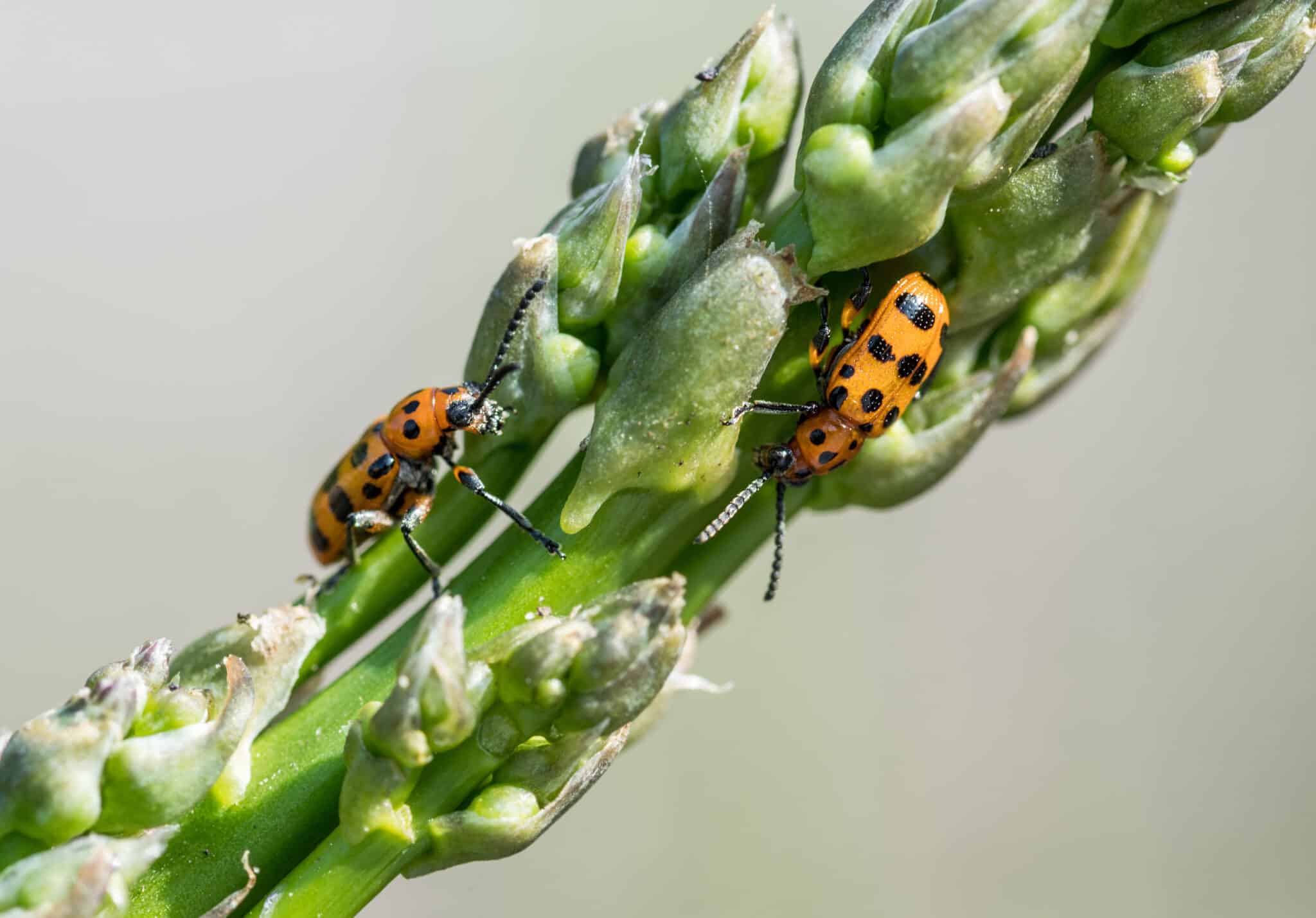
Asparagus, a spring delicacy that is highly sought-after by chefs and home cooks alike, is one of the very first vegetables that is ready to be harvested in the season. This delicious perennial vegetable, with its tender shoots, can easily be grown in any home garden, allowing you to enjoy fresh and flavorful asparagus right at home. Of course, as a crop that takes time to mature, it requires patience and care before yielding any harvests. It typically takes around three years of nurturing before you can expect your first bountiful harvest. However, the pay-off is worth it as this amazing plant has the ability to continuously produce asparagus spears for over 20 years. Imagine, years of delectable asparagus recipes, all thanks to the simple act of learning how to grow asparagus at home.
Pet safety; Whilst cooked asparagus in safe in moderation for dogs, berries and ferns of the asparagus are toxic to both humans and pets, use caution when choosing where to plant asparagus plants.
When To Plant
Leaning how to grow asparagus is a great way to add a delicious and healthy vegetable to your home garden. When starting your plants, it’s important to keep in mind that they have a long growing period. Seed starting should begin about four weeks before the last frost, but it is recommended that you purchase crowns instead. This is because the period for asparagus plants to mature from seed can be quite lengthy, often taking more than three years to mature.
Fortunately, crowns are widely available in garden stores as bare roots, typically sold and ready to be planted in the spring. With proper care, your asparagus crowns will provide you with years of delicious harvests!
Selecting The Right Location
Asparagus, a perennial vegetable, has a long lifespan of over 20 years. As such, it is essential to choose the right location to plant this vegetable, ensuring it has optimal growing conditions and longevity. Consider creating a special bed or using companion planting techniques to enhance their productivity.
Moreover, when selecting the perfect location, you should prioritize the availability of a lot of sun exposure and well-drained soil that is rich in organic matter. Adequate spacing and soil preparation are also critical when planting.
Preparing The Soil
Preparing the soil for asparagus planting is an important step in ensuring a healthy and productive crop.
Begin by conducting a soil test to assess its pH level and nutrient composition. Asparagus thrives in well-draining soil with a pH level between 6.0 and 7.0. Based on your soil test results, make necessary adjustments by adding lime to raise pH or sulfur to lower it.
Next, amend the soil with organic matter, such as compost or well-rotted manure, to improve its fertility and structure. Add this organic material into the top 12 inches of soil, as asparagus have deep root systems. To increase drainage, consider creating raised beds, which provide excellent soil aeration and prevent water logging.
Choosing Planting Methods
When it comes to growing asparagus, there are two primary methods to choose from: planting from seeds or crowns. Each method comes with its own set of pros and cons.
Planting from seeds is the most cost-effective option and offers a wider variety of asparagus cultivars to choose from. However, it requires more time and patience, as it can take several years for seed-grown asparagus to mature and produce a significant harvest.
On the other hand, planting from crowns provides a head start, allowing you to enjoy a harvest in the first or second year. Crowns are also less susceptible to diseases and pests early on. However, they can be more expensive, and the selection of cultivars may be limited.
Ultimately, the choice between seeds and crowns depends on your preferences, patience, and budget.
Planting Asparagus
Whether you’re working with crowns or seeds, start by preparing a well-drained, sunny spot in your garden with soil that’s been enriched with organic matter.
For crowns, dig trenches around 12-18 inches deep, spaced about 12-18 inches apart within rows, with rows spaced 3-4 feet apart. Place the crowns at the bottom of the trenches, spreading out their roots, and cover them with 2 inches of soil. As they grow, gradually fill in the trenches.
When planting from seeds, sow them about 1/2 inch deep in rows spaced 18 inches apart. Keep the soil consistently moist but not waterlogged to aid germination.
Once the asparagus plants establish themselves, provide regular watering, aiming for about 1-1.5 inches of water per week.
Care and Maintenance
Caring for asparagus involves several essential tasks to ensure healthy growth and abundant harvests.
Adequate watering is crucial, especially during the growing season, make sure you keep the soil consistently moist but not waterlogged. Apply mulch around the asparagus bed to retain moisture, regulate soil temperature, and suppress weeds. Asparagus plants appreciate fertilization in the early spring before the first spears appear. Ensure you use an organic or homemade fertilizer.
As the season progresses, keep an eye out for weeds, which can compete for nutrients and water. Regularly remove weeds by hand, being careful not to damage the shallow asparagus roots. Prune or snap off any dead or yellowing ferns in late fall or early winter to prevent overwintering pests and diseases.
Harvesting Asparagus
Harvesting asparagus is a delicate balance between patience and reward. It’s essential to resist the temptation to over-harvest during the first few years to allow the plants to establish strong, healthy root systems. You should refrain from harvesting at all the first year you spot spears to encourage a larger harvest the following year.
Typically, you can begin harvesting when asparagus spears reach about 6-8 inches in height. To harvest, gently snap or cut the spears at ground level just below the soil surface, using a sharp knife or your fingers. Avoid damaging any emerging spears nearby.
Asparagus should be harvested consistently but sparingly during the first two years, extending the harvest season to about 2-4 weeks. In subsequent years, you can gradually increase the harvest period to 6-8 weeks. Once the spears become thinner, it’s a signal to stop harvesting, allowing the remaining spears to grow into tall, fern-like foliage. This foliage is needed for photosynthesis, allowing the plant to store energy for the next growing season.
Dealing With Pests And Disease
Dealing with pests and diseases in asparagus cultivation requires a proactive and organic approach to ensure a healthy harvest.
Common pests that can afflict asparagus include asparagus beetles, aphids, and nematodes, while diseases such as rust and fusarium can pose challenges. To prevent infestations and infections, practice good garden hygiene by removing old ferns and plant debris in the fall to eliminate overwintering sites.
Additionally, encourage beneficial insects like ladybugs and lacewings, which can help control pest populations naturally. For asparagus beetle control, handpick or use neem oil-based sprays.
To combat rust, ensure good air circulation and avoid overhead watering. If nematodes become an issue, consider companion planing with insect repelling plants.
Organic remedies like diatomaceous earth and companion planting with marigolds can also deter pests, but should be used sparingly as they also negatively affect beneficial insects.
By adopting these eco-friendly practices, you can maintain a pest and disease-resistant asparagus patch while preserving the health of your plants and the environment.

Over Wintering And Dormancy
Overwintering and dormancy care are essential to ensure the longevity and vitality of your asparagus plants.
As winter approaches, allow the asparagus ferns to naturally turn yellow and brown, signaling their entry into dormancy. Prune or cut down these dried-out ferns, leaving a few inches above the ground to protect the crowns from extreme cold. Applying a layer of mulch, such as straw or leaves, around the base of the asparagus bed can help insulate the soil and maintain a consistent temperature.
Be vigilant about removing weeds during the winter to prevent them from competing with the asparagus in the spring. Additionally, monitor for signs of pests or diseases that may have overwintered in the soil or plant debris, and take appropriate measures if necessary.
Proper overwintering care ensures that your asparagus plants will emerge healthy and vigorous when the growing season returns, ensuring a continued bountiful harvest year after year.
Companion Planting
Companion planting with asparagus is an effective strategy to boost growth and deter pests naturally.
One excellent companion for asparagus is tomatoes, as their growth habits and nutrient requirements complement each other. Basil, parsley, and nasturtiums also make great companions, enhancing flavor and repelling aphids, asparagus beetles, and nematodes.
Marigolds, with their strong scent, deter nematodes and other soil-borne pests. Planting dill, coriander, or cilantro near your asparagus can attract beneficial insects like ladybugs and parasitic wasps, which help control harmful pests.
Avoid planting asparagus alongside onions or garlic, as they can compete for nutrients.
Harvesting Seeds And Propogation
When it comes to growing asparagus from seeds, the process of harvesting and propagating seeds is a key aspect of maintaining a sustainable asparagus garden.
To harvest asparagus seeds, allow some of the mature ferns to develop red berries in late summer or fall. Once these berries turn bright red, collect them and remove the seeds. Afterward, thoroughly rinse and dry the seeds before storing them in a cool, dry place until you’re ready to plant.
When it’s time to propagate, start the seeds indoors in early spring, about 8-12 weeks before the last expected frost. Plant the seeds in seed trays or small pots, and once they’ve developed into healthy seedlings, transplant them into your garden when the soil is warm enough.
Keep in mind that growing asparagus from seeds requires more time and patience compared to using crowns, but it can be a rewarding and cost-effective method for expanding your asparagus patch and ensuring a long-lasting supply of this delicious perennial vegetable.


